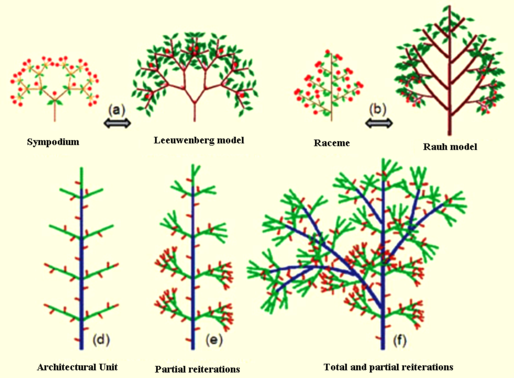GreenLab Course
Overview
Plant Architecture.
Plant structure
-
Architectural botany
- the axis building mode: continuous or rhythmic
- the position of sexuality: lateral or terminal
- the branching occurrence pattern: immediate or delayed
- the branching pattern into shoots
- the direction of axis development (vertical with branches developing in a spiral / horizontally with branches developing in a plane)
- ...
In the 70s, botanists Francis Hallé and Roelof Oldeman extended the inflorescence
structural pattern classification to tree structures.
They created a new approach to Botany: Architectural Botany.
Inflorescence patterns where classified according to their regular geometrical patterns.
In architectural botany, plant structure is described according to a specific axis typology,
according to axis traits:
In young trees, a different axis typology can be observed, showing different morphological stages: vigorous shoots on trunk, up to a short axis usually bearing sexuality.
They are qualified by a physiological age (1 for the trunk, 2 for vigorous branches, 3 for branches, 4 for short axes, etc. )
A specific axis typology may be found at several places in the plant structure.
These different axis develop according to a specific combination, or strategy, following one of the 23 architectural model defined by the botanist community.
Each plant species expresses its architectural model with its own specific parameters, defining its architectural unit.
The architectural unit can be considered as a stable plant genetic development scheme.
When the tree matures and becomes older, the plant structure duplicates its architectural unit, either fully or partially.
This process, called reiteration, allows the building of huge complex crowns.
In the botanical architectural approach, plant structure is not considered as static.
Plant structure results from the dynamics of leafy shoots formation, derived from terminal and lateral buds.
Simulating plant structure
-
The architectural unit defines a basis for plant structure modelling and simulation
Plant structure can be generated by a computer program, using a procedural approach.
Successive development stages are obtained by applying rules to the terminal and axillary buds of the existing structure.
Rules are defined for each physiological age, translating the botanical branching patterns, sexuality occurrences and growth modes.
They may introduce stochastic aspects, including dormancy and viability aspects.
Rules can be implemented by automatons, grammars or dedicated procedures.

Plant architecture (© Liama, CASIA).
-
Top: Inflorescence patterns and architectural models.
Botanists have defined 23 architectural models to characterize a plant structure development strategy
Leeuwenberg's model corresponds to a Symposium inflorescence pattern.
Rauh's model is one expression of a Raceme inflorescence pattern.
Bottom: A simulated young tree and older stages with partial and total reiteration
Left: The young tree expresses its architectural unit
Middle: Partial reiteration appears
Right: Total reiterations appear, developing the crown
The colour stands for the various physiological ages: vigorous axes in blue, branches in green, short axis bearing sexuality in red.
